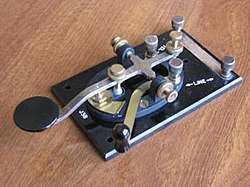Morse code is a type of character encoding that transmits telegraphic information using rhythm. Morse code uses a standardized sequence of short and long elements to represent the letters, numerals, punctuation and special characters of a given message. The short and long elements can be formed by sounds, marks, or pulses, in on off keying and are commonly known as "dots" and "dashes" or "dits" and "dahs". The speed of Morse code is measured in words per minute (WPM) or characters per minute.
Originally created for Samuel F. B. Morse's electric telegraph in the early 1840s, Morse code was also extensively used for earlyradio communication beginning in the 1890s. In the early part of the twentieth century, the majority of high-speed international communication was conducted in Morse code, using telegraph lines, undersea cables, and radio circuits. However, the variable length of the Morse characters made it hard to adapt to automated circuits, so for most electronic communication it has been replaced by machine readable formats, such as Baudot code and ASCII.
The most popular current use of Morse code is by amateur radio operators, although it is no longer a requirement for amateur licensing in many countries. In the professional field, pilots and air traffic controllers are usually familiar with Morse code and require a basic understanding. Navigational aids in the field of aviation, such as VORs and NDBs, constantly transmit their identity in Morse code. Morse code is designed to be read by humans without a decoding device, making it useful for sending automated digital data in voice channels. For emergency signals, Morse code can be sent by way of improvised sources that can be easily "keyed" on and off, making Morse code one of the most versatile methods of telecommunication in existence.
Development and history
In contrast, Morse's and Vail's initial telegraph, which first went into operation in 1844, made indentations on a paper tape when an electrical current was transmitted. Morse's original telegraph receiver used a mechanical clockwork to move a paper tape. When an electrical current was received, an electromagnet engaged an armature that pushed a stylus onto the moving paper tape, making an indentation on the tape. When the current was interrupted, the electromagnet retracted the stylus, and that portion of the moving tape remained unmarked.Beginning in 1836, Samuel F. B. Morse and Alfred Vail developed an electric telegraph, which sent pulses of electrical current to control an electromagnet that was located at the receiving end of the telegraph wire. The technology available at the time made it impossible to print characters in a readable form, so the inventors had to devise an alternate means of communication. In 1837, William Cooke and Charles Wheatstone began operating electric telegraphs in England that also had electromagnets in the receivers; however, their systems used needle pointers that rotated to indicate the alphabetic characters being sent.
The Morse code was developed so that operators could translate the indentations marked on the paper tape into text messages. In his earliest code, Morse had planned to only transmit numerals, and use a dictionary to look up each word according to the number which had been sent. However, the code was soon expanded by Alfred Vail to include letters and special characters, so it could be used more generally. The shorter marks were called "dots", and the longer ones "dashes", and the letters most commonly used in the English language were assigned the shortest sequences.
In the original Morse telegraphs, the receiver's armature made a clicking noise as it moved into and out of position to mark the tape. Operators soon learned to translate the clicks directly into dots and dashes, making it unnecessary to use the paper tape. When Morse code was adapted to radio, the dots and dashes were sent as short and long pulses. It was later found that people become more proficient at receiving Morse code when it is taught as a language that is heard, instead of one read from a page.To reflect the sound of Morse code, practitioners began to vocalise a dot as "dit", and a dash as "dah".
Morse code was an integral part of international aviation. Commercial and military pilots were required to be familiar with it, both for use with early communications systems and identification of navigational beacons which transmitted continuous two- or three-letter identifiers in Morse code. Aeronautical charts show the identifier of each navaid next to its location on the map.
Morse code was also used as an international standard for maritime communication until 1999, when it was replaced by the Global Maritime Distress Safety System. When the French navy ceased using Morse code in 1997, the final message transmitted was "Calling all. This is our last cry before our eternal silence."













